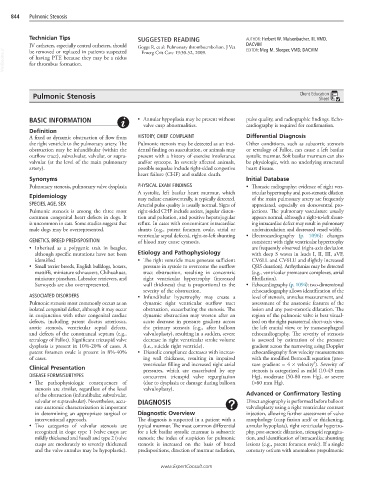Page 1680 - Cote clinical veterinary advisor dogs and cats 4th
P. 1680
844 Pulmonic Stenosis
Technician Tips SUGGESTED READING AUTHOR: Herbert W. Maisenbacher, III, VMD,
IV catheters, especially central catheters, should Goggs R, et al: Pulmonary thromboembolism. J Vet DACVIM
EDITOR: Meg M. Sleeper, VMD, DACVIM
VetBooks.ir of having PTE because they may be a nidus
be removed or replaced in patients suspected
Emerg Crit Care 19:30-52, 2009.
for thrombus formation.
Pulmonic Stenosis Client Education
Sheet
BASIC INFORMATION • Annular hypoplasia may be present without pulse quality, and radiographic findings. Echo-
valve cusp abnormalities. cardiography is required for confirmation.
Definition
A fixed or dynamic obstruction of flow from HISTORY, CHIEF COMPLAINT Differential Diagnosis
the right ventricle to the pulmonary artery. The Pulmonic stenosis may be detected as an inci- Other conditions, such as subaortic stenosis
obstruction may be infundibular (within the dental finding on auscultation, or animals may or tetralogy of Fallot, can cause a left basilar
outflow tract), subvalvular, valvular, or supra- present with a history of exercise intolerance systolic murmur. Soft basilar murmurs can also
valvular (at the level of the main pulmonary and/or syncope. In severely affected animals, be physiologic, with no underlying structural
artery). possible sequelae include right-sided congestive heart disease.
heart failure (CHF) and sudden death.
Synonyms Initial Database
Pulmonary stenosis, pulmonary valve dysplasia PHYSICAL EXAM FINDINGS • Thoracic radiography: evidence of right ven-
A systolic, left basilar heart murmur, which tricular hypertrophy and post-stenotic dilation
Epidemiology may radiate cranioventrally, is typically detected. of the main pulmonary artery are frequently
SPECIES, AGE, SEX Arterial pulse quality is usually normal. Signs of appreciated, especially on dorsoventral pro-
Pulmonic stenosis is among the three most right-sided CHF include ascites, jugular disten- jections. The pulmonary vasculature usually
common congenital heart defects in dogs. It tion and pulsation, and positive hepatojugular appears normal, although a right-to-left shunt-
is uncommon in cats. Some studies suggest that reflux. In cases with concomitant intracardiac ing intracardiac defect may result in pulmonary
male dogs may be overrepresented. shunts (e.g., patent foramen ovale, atrial or undercirculation and decreased vessel width.
ventricular septal defects), right-to-left shunting • Electrocardiography (p. 1096): changes
GENETICS, BREED PREDISPOSITION of blood may cause cyanosis. consistent with right ventricular hypertrophy
• Inherited as a polygenic trait in beagles, are frequently observed (right-axis deviation
although specific mutations have not been Etiology and Pathophysiology with deep S waves in leads I, II, III, aVF,
identified • The right ventricle must generate sufficient CV6LL and CV6LU and slightly increased
• Small terrier breeds, English bulldogs, boxers, pressure in systole to overcome the outflow QRS duration). Arrhythmias may be detected
mastiffs, miniature schnauzers, Chihuahuas, tract obstruction, resulting in concentric (e.g., ventricular premature complexes, atrial
miniature pinschers, Labrador retrievers, and right ventricular hypertrophy (increased fibrillation).
Samoyeds are also overrepresented. wall thickness) that is proportional to the • Echocardiography (p. 1094): two-dimensional
severity of the obstruction. echocardiography allows identification of the
ASSOCIATED DISORDERS • Infundibular hypertrophy may create a level of stenosis, annulus measurement, and
Pulmonic stenosis most commonly occurs as an dynamic right ventricular outflow tract assessment of the anatomic features of the
isolated congenital defect, although it may occur obstruction, exacerbating the stenosis. The lesion and any post-stenotic dilatation. The
in conjunction with other congenital cardiac dynamic obstruction may worsen after an region of the pulmonic valve is best visual-
defects, including patent ductus arteriosus, acute decrease in pressure gradient across ized on the right parasternal short-axis view,
aortic stenosis, ventricular septal defects, the primary stenosis (e.g., after balloon the left cranial view, or by transesophageal
and defects of the conotruncal septum (e.g., valvuloplasty), resulting in a sudden, severe echocardiography. The severity of stenosis
tetralogy of Fallot). Significant tricuspid valve decrease in right ventricular stroke volume is assessed by estimation of the pressure
dysplasia is present in 10%-20% of cases. A (i.e., suicide right ventricle). gradient across the narrowing using Doppler
patent foramen ovale is present in 8%-40% • Diastolic compliance decreases with increas- echocardiography flow velocity measurements
of cases. ing wall thickness, resulting in impaired with the modified Bernoulli equation (pres-
2
ventricular filling and increased right atrial sure gradient = 4 × velocity ). Severity of
Clinical Presentation pressures, which are exacerbated by any stenosis is categorized as mild (10-49 mm
DISEASE FORMS/SUBTYPES concurrent tricuspid valve regurgitation Hg), moderate (50-80 mm Hg), or severe
• The pathophysiologic consequences of (due to dysplasia or damage during balloon (>80 mm Hg).
stenosis are similar, regardless of the level valvuloplasty).
of the obstruction (infundibular, subvalvular, Advanced or Confirmatory Testing
valvular or supravalvular). Nevertheless, accu- DIAGNOSIS Direct angiography is performed before balloon
rate anatomic characterization is important valvuloplasty using a right ventricular contrast
in determining an appropriate surgical or Diagnostic Overview injection, allowing further assessment of valve
interventional approach. The diagnosis is suspected in a patient with a morphology (cusp fusion and/ or thickening,
• Two categories of valvular stenosis are typical murmur. The most common differential annular hypoplasia), right ventricular hypertro-
recognized in dogs: type 1 (valve cusps are for a left basilar systolic murmur is subaortic phy, post-stenotic dilatation, tricuspid regurgita-
mildly thickened and fused) and type 2 (valve stenosis; the index of suspicion for pulmonic tion, and identification of intracardiac shunting
cusps are moderately to severely thickened stenosis is increased on the basis of breed lesions (e.g., patent foramen ovale). If a single
and the valve annulus may be hypoplastic). predispositions, direction of murmur radiation, coronary ostium with anomalous prepulmonic
www.ExpertConsult.com

